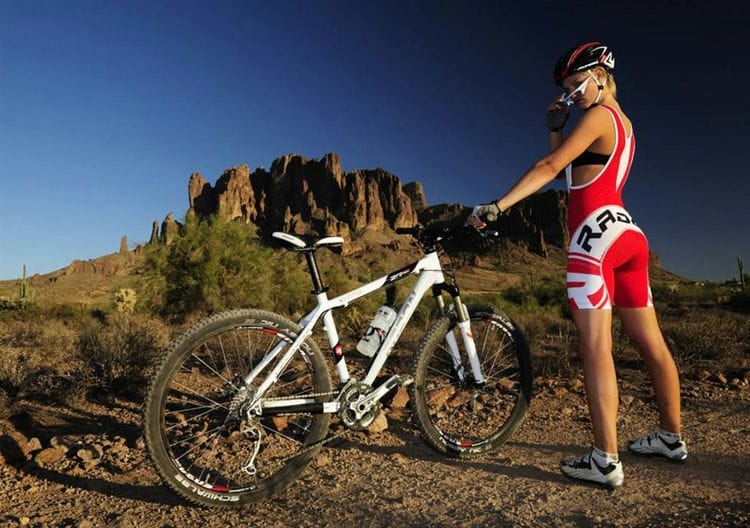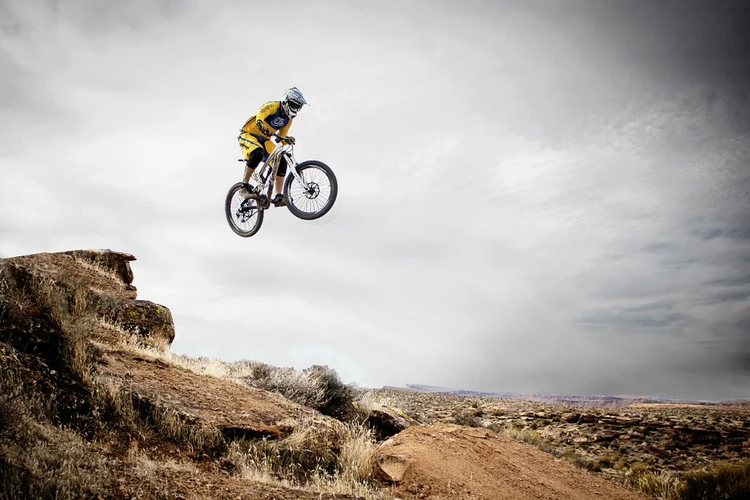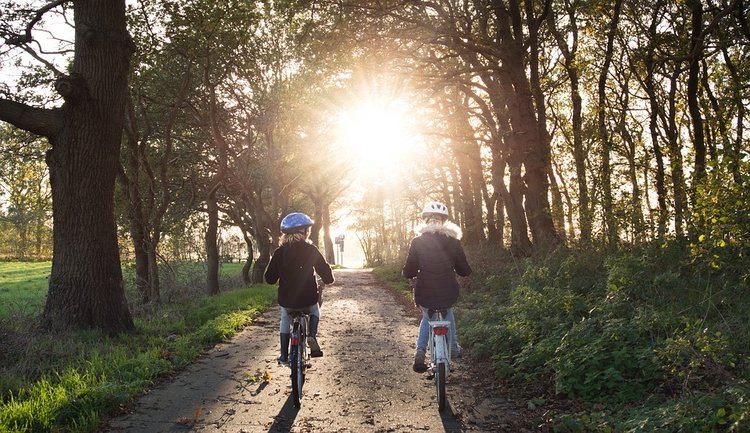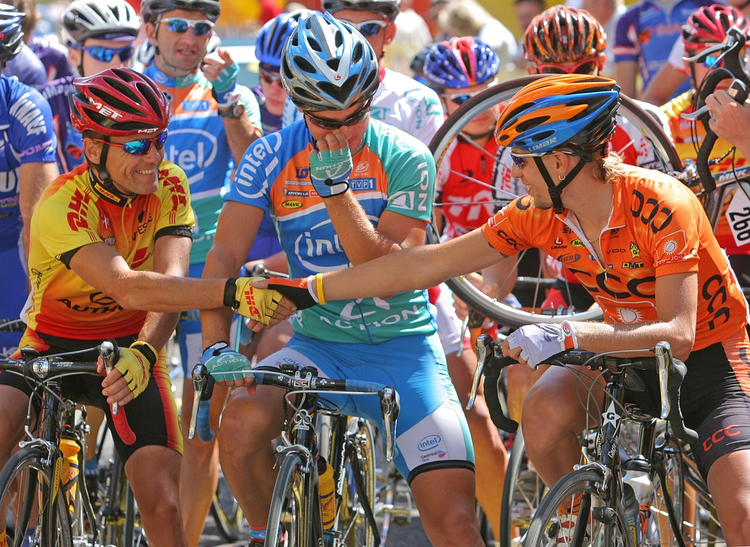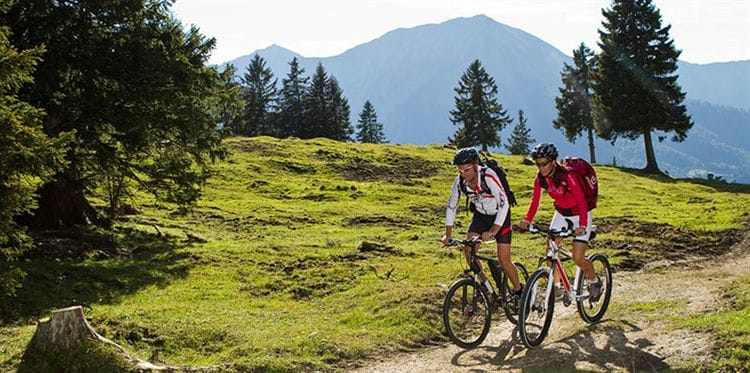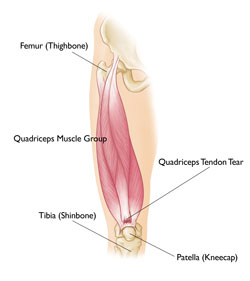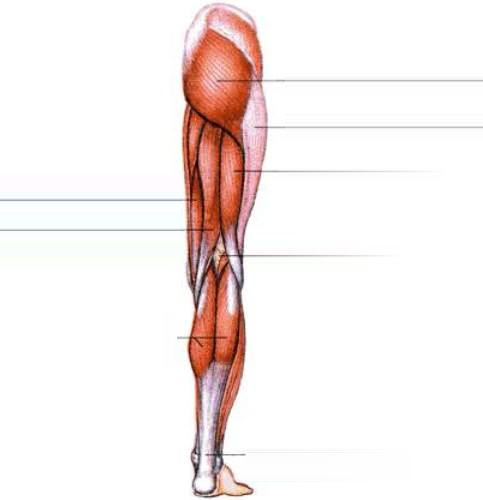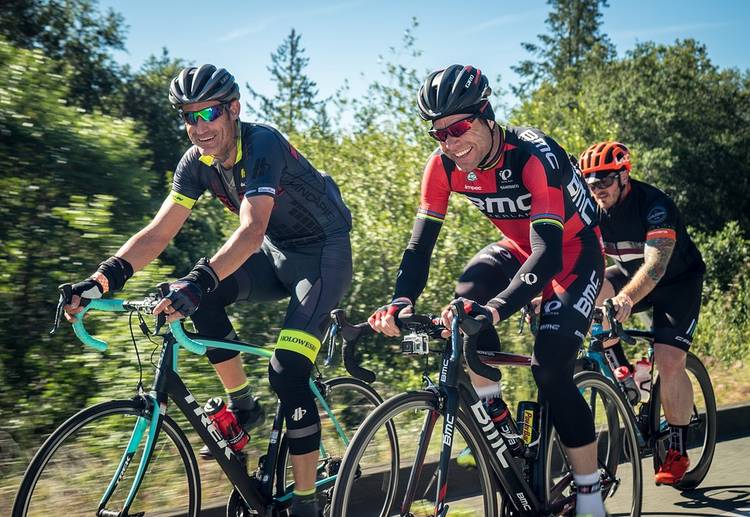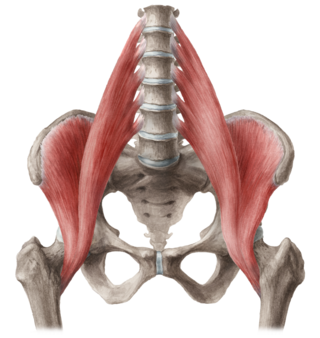A detailed description of which muscles are involved when cycling. What muscles are involved in cycling?
Pedaling phases
The leg movements seem simple and easy, but in fact, each pedal rotation trains many muscles. Moreover, when the agonist muscles contract, the antagonist muscles relax. In order to understand what muscles the bicycle develops and when certain zones of the legs are activated and relaxed, we will consider two phases of the bicycle pedal stroke: the strong phase and the recovery phase.
Power phase
- The cyclist uses the hip extensors (gluteus maximus) to push the pedal down from the upright position. This is the beginning of a strong phase, which lasts from the starting position of 12 o’clock until the pedal reaches the 3 o’clock position.
- In the 3 to 5 o’clock position, the extensors of the knee are activated: the vastus lateralis muscle and the vastus medialis femoris. Most cyclists do their best at this stage. The load increases significantly when going uphill or while standing.
- In the 5 to 6 o’clock position, the ankle and foot flexors are activated, the calf muscle is engaged, and the toes are pushed outward (plantar flexion)
Recovery phase
- In the 6 to 8 o’clock position, the lateral ankle flexors work actively and dorsiflexion (dorsiflexion) is performed.
- In the 8 to 10 o’clock position, the hip flexors (semimembranosus, semitendinosus, and biceps) pull the heel towards the buttocks.
- At the 10 o’clock to 12 o’clock position, the hip flexors (iliacus and psoas) complete the pedal stroke of the bicycle.
Functions of the muscles of the legs and their work during the rotation of the pedals of the bicycle
| Muscle name | Alternative (more common) name | Cycling function |
| Broad medial femoris muscle | Quadriceps | Knee extension combined with strong hip flexion |
| Biceps femoris | Hip biceps | Stretching the heel towards the buttocks during the recovery phase. |
| Gluteus maximus muscle | Buttocks | Initiating a Downward Leg Movement at the Beginning of the Recovery Phase |
| Iliac and psoas muscles | Hip flexors | Hip flexion |
| Lateral broad muscle of the thigh | Hip extensors | Extension of the hip when pushing the pedal down at the beginning of a strong phase |
| Calf muscle | Upper leg | Strong plantar flexion |
| Flounder muscle | Lower leg | Knee flexor function |
| Semi-membranous and semitendinosus muscles | Hamstrings | Recovery leg movement (with hamstrings) |
| Tibialis anterior muscle | Front of the lower leg | Stretching the toes towards the lower leg (dorsiflexion) |
Buttocks
The gluteus muscles work in conjunction with the quadriceps (quadriceps), causing the pedals to rotate. In addition, they also help the rider stay in the saddle.
Press
This muscle is also active. At the same time, various parts of it are being worked out. For example, when moving, almost all parts of the muscle are directly involved, and their work is aimed at keeping the body in the desired position, and with sharp turns, the lateral beams are activated
Arms and shoulders
At first glance, it may seem that the cyclist’s upper body is absolutely not working when riding. And this opinion finds obvious confirmation in the physique of professional athletes – they have very developed muscular legs, but at the same time their arms and shoulders, as a rule, lag far behind.
But in fact, the muscles in the arms and shoulders, although not as much as the muscles in the legs, also work when riding. Especially if it is skiing in the mountains, off-road, sand, etc. To lock the steering wheel in a static position, you will definitely need to strain your arms and shoulders. Otherwise, the bike will simply wobble and you will lose your balance.
The triceps play the most important role. They act as shock absorbers, allowing you to control the distance from the cyclist’s chest to the handlebars, thereby compensating for the stresses that arise when hitting obstacles or getting into a hole.
Of course, do not forget about the work of the muscles of the arms when lifting the bike to the desired floor or stairs. Although such a load will not pump your muscles, it will definitely keep them in good shape!
Body pumping
People are just as interested in which trunk muscle groups work when cycling. And they also wonder if the press is swinging. Knowing thoroughly for this human anatomy is not necessary. Already at the first revolutions of the bicycle pedals, you can feel that the process actively includes:
- Muscles of the buttocks. They work in tandem with the quadriceps. In addition, they maintain balance while driving, which is why the level of load on them increases several times.
- Abdominal muscles. For a more thorough study of the press, you need to properly sit on the bike. The ability to keep the body straight when leaning forward makes the riding process much more comfortable, significantly strengthens both the abdominal and lumbar muscles.
- Arms and shoulders. The load on these groups is made much less frequently. However, the shoulder girdle is actively working when turning the steering wheel or holding the bike while going down a hill. In addition, the muscles have to be used when it is necessary to pedal while standing, as well as on steep climbs.
Any irregularities encountered along the way are a kind of obstacle that impedes driving. They make your back and abs workout much more effective.
Many people think that it is best if the workout involves the entire muscular system, but this is not entirely true. First of all, you should take into account the characteristics of your body. For example, for those who are overweight or prone to varicose veins of the lower extremities, cycling training should be started on flat terrain, where there are no all kinds of defects in the surface of the road surface, so as not to strain the back and strain the blood vessels.
For women, it is important which muscles work when cycling, and whether there are special rules for gaining muscle mass. Long workouts should not be overused for this. It is best to go on a bike ride twice a day for one hour. The speed should be faster, while pedaling should be done in an even, smooth and constant motion. Whether the gluteal muscles swing is another main topic of discussion for the fair sex. An important condition in this case will be constant riding while standing on the pedals. However, you should not forget about changing exercises during movement, otherwise the buttocks will not acquire an ideal shape.
The muscles of the buttocks work in tandem with the quadriceps, maintaining balance while riding, due to which the load on them increases several times
Tilting the body slightly forward makes the ride itself more comfortable and significantly strengthens both the abdominal and lumbar muscles
The shoulder girdle is actively used when turning the steering wheel or holding the bike while going down a hill
Stretching for recovery
In the process of training, fatigue gradually accumulates, which directly affects the work of the muscles. Stretching can help relax and repair muscles.
Among the main types of stretching, active, passive, dynamic, ballistic and static are distinguished. With active stretching, the athlete uses their own efforts to stretch the leg muscles. Passive stretching requires the help of a third party to help stretch the cyclist’s muscles. Dynamic stretching is performed until the muscles feel tense. Ballistic stretching is based on snatching and springy exercises. Static stretching is considered the most popular type of cool-down, in which the athlete remains in a certain position to stretch the muscles for 20-60 seconds.
Each athlete chooses the most convenient and suitable way to complete an intense workout. However, regardless of the type of stretch, it is worth remembering that a high-quality hitch will help reduce the soreness and disperse the lactic acid that usually accumulates during sports.
Tips on how to ride a bike more efficiently for muscle training
- Remember that muscles train, and also promotes their growth, only an ever-increasing load. If you feel pain in the muscles the next day, this means that the training was a success, and your efforts were not in vain. The load should be increased.
- Regular cycling at a leisurely pace will not allow you to build muscle. In order for the muscles to work most efficiently, it takes a lot of work and regular training.
- Interestingly, the muscles work at different intensities. So, in a cycle from twelve to six (or when pressing the pedal), the gastrocnemius muscle, muscles of the thighs and buttocks are maximally used. In the cycle from six to nine o’clock – the back of the thigh. And in the cycle from nine to twelve o’clock – the iliac muscle.
- Muscles actively work in this way only under the condition of circular pedaling. Therefore, cycling shoes are needed, as well as clipless pedals.
- With pronounced soreness in the muscles, a bathhouse, a sauna, and a warm shower will help. You can also do self-massage. Stretching is necessary after training. The fact that the muscles are aching means that they are swaying. Dont be upset.
- Often, after the load was too intense, cramps in the calves may occur. It is especially unpleasant if it happens at night. This suggests that the body lacks potassium ions (they could be released along with sweat). Therefore, the deficit should be replenished: eat baked potatoes, a handful of raisins, drink dried fruit compote.
Benefits from classes
As users learn which muscles are strengthened by cycling, rides on a two-wheeled vehicle become more frequent. Classes have a number of other advantages:
- improving the functioning of the vestibular apparatus;
- increased immunity;
- reducing the risk of heart attack and stroke;
- improved blood flow;
- losing weight;
- getting rid of stress and depression.
Bicycle trains are obligatory for those who are inactive, work in the office and spend a lot of time at school. The systematic training provides the prevention of a number of diseases, including contributing to weight loss and prevents muscles from atrophy. In general, this active type of recreation is suitable for absolutely everyone, from small to large.
The benefits of cycling for women are obvious. Firstly, as a result of constant physical exertion, you can get rid of fat deposits from the thighs and buttocks, significantly reduce cellulite. Secondly, girls who have acquired such a useful habit have a better pregnancy in the future and less risk of complications during childbirth.
Since when riding a bicycle, not only muscles are trained, but also many other systems of the body, training will provide a surge of vivacity and good mood for children. In addition, riding allows you to form good posture and a strong spine, increase endurance and willpower. While riding, the long muscles of the body, back, lower back and feet work, which is of great importance for flat feet in a child.
The increase in muscle mass directly depends on which muscles are swaying when cycling. This especially applies to the calf, hip groups, the press. At the same time, the strength and elasticity of the ligaments and joints increases. Plus, training becomes an excellent preventive procedure for somatoform autonomic disorders of the nervous system and heart disease. This is especially important for men, since in most cases it is cardiovascular pathologies that become one of the main causes of erectile dysfunction.
You can find out what percentage of body muscles are involved and how many calories are burned during each type of training, in particular, cycling, for one hour, in the table below.
|
Jogging |
Burns 300 kilocalories |
Works 45% of the muscles of the body |
|
Bike ride |
Burns 500 kilocalories |
Works 50% of the muscles of the body |
|
Nordic walking |
Burns 700 kilocalories |
Works 90% of the muscles of the body |
Cycling is shown to those who lead a sedentary lifestyle, work in the office or spend a lot of time at school
Regular exercise prevents a range of diseases and promotes weight loss
While riding, the long muscles of the body, back, lower back and feet work, which is especially important for flat feet in a child
Cycling becomes an excellent preventive procedure for somatoform autonomic disorders of the nervous system and heart disease
Muscles of the lower extremities
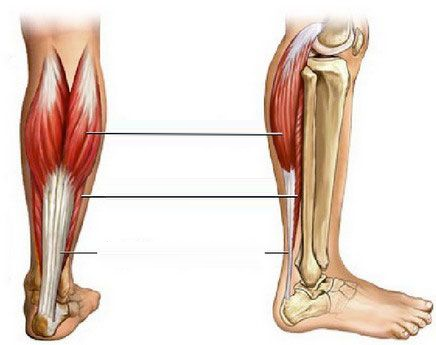
Lower leg: gastrocnemius, soleus and feathery muscles
Naturally, the first thing that comes to mind is that a bicycle affects the development of the muscles of the lower leg and hips. This is indeed the case. Cyclists have slender, muscular legs. First and foremost, calf muscles, such as the calf and the deeper soleus, will only work well when the cyclist uses “extra pump” – apart from leg extension at the knee, as they approach the “bottom dead center” – the vertical position of the lower pedal – an additional foot movement is performed, similar to lifting on toes. This summation of muscular effort helps to increase the load when riding uphill.
It is important that the work of the lower leg muscles is somewhat different from other large muscles. They are more resilient due to the structure of their muscle tissue and are able to consume less oxygen.
If the cyclist puts his feet in toe clips or uses special shoes, then raising the leg up is not passive. However, in this case, the muscles of the thighs are mainly working, not the lower legs.
Thigh muscle groups: quadriceps (front), biceps (back group).
Without exaggeration, the front muscles of the thigh (quadriceps) are the main ones that experience stress when riding.
Their function is to straighten the leg at the knee joint.
The back muscle of the thigh – biceps – together with the semimembranosus and semitendinosus muscles, is capable of working in the opposite function – flexion. Therefore, riding in toe clips contributes to the harmonious development of the thigh muscles and the improvement of the blood supply to the muscle tissue, as well as the strengthening of the ligamentous apparatus.
The muscles of the girdle of the lower extremities: the gluteus maximus and minor are involved. Their function is synergy. They are included in the movement along with the quadriceps muscles, coordinating their work.
Since the gluteal muscles are the largest in the human body, their constant work leads to a significant expenditure of energy. In addition, the buttocks, shifting from the saddle alternately to the sides, help not to fall and contribute to balance when deviating from a straight path.
Possible contraindications
What muscles are trained when riding, and how this helps to keep the body in excellent physical shape, is somewhat understandable. But like any sport, cycling has its own contraindications. Pedaling is prohibited for those who have:
- violations of the vestibular apparatus;
- scoliosis and hernia of the spine;
- pathology of the cardiovascular system;
- disturbances in the work of cerebral vessels;
- various injuries and diseases.
It is advisable not to get carried away with walks during pregnancy and take into account that rather frequent cycling affects not only muscles, but also the cardiovascular system, as well as the respiratory system. In addition, to avoid injury or a dangerous situation, you need to be very prudent and careful. This is especially true when users are just starting to learn techniques and are not well aware of which muscles work while cycling on different parts of the route.
You should refuse to ride a bike in case of violations of the vestibular apparatus, scoliosis and pathologies of the cardiovascular system
It is advisable not to get carried away with walks on a two-wheeled vehicle and during pregnancy
What is the most effective way to build muscle while cycling?
While we’re on the subject of what muscles swing when cycling, let’s also look at a few basic rules that will help you improve your efficiency:
- Increase volumes. The key to effective muscle development is constant progression. Therefore, if you want your muscles to develop, constantly increase the amount of skating. If today you have driven 1 km, then next time try to drive 2 km, etc.
- Make your bike rides varied. You should not constantly ride the same route. Better to alternate, for example, driving over rough terrain and asphalt roads. Thus, you will be able to adapt your muscular apparatus to various types of loads and work it out better. Alternatively, you can experiment with speeds. For example, the Dewolf TRX 50 bike has 24 speeds, which will allow you to control the load on your legs.
- Use special equipment. If you are serious about using your bike as a leg trainer, then you should consider purchasing cycling shoes and clipless pedals. This will provide a constant circular load, which significantly increases the pumping efficiency.
It is also worth understanding that for a comprehensive pumping of the legs (and even more so the whole body), you definitely will not only have enough riding a bike. You will also need to connect various general physical exercises.
Slowly but surely to victory
If during the trip you can talk calmly without gasping for breath, then the pace is right.
A more accurate method would be to use a heart rate sensor or power meter. For those using a heart rate sensor, the base zone will be 60-70% of the maximum value. If using a power meter, target 56-75% of the functional threshold power (FTP).
Traveling at this intensity teaches your body to burn fat instead of glycogen. Glycogen is how our body stores carbohydrates, but its stores are limited and usually last for 30-90 minutes of intense training. To ride for 5-6 hours, the body uses fats, but in order to burn them, you need a certain amount of carbohydrates – so do not forget to eat during your basic workout.
As the intensity of the workout increases, more glycogen and less fat are burned. Basic training makes this process more efficient. The higher the intensity at which your body uses fats as a source of energy, the more glycogen will be stored for the final attack.
Iliac muscles
It is the iliac muscles, which are located between the groin and the spine, that help both flexion and extension of the hip, but they will only work if the biker has contact pedals and the leg pulls the pedal with active muscle contraction. Only in this case riding a bike develops the iliac muscles.
Cycling Performance for Muscles: Additional Recommendations
The muscles that are used when cycling can be worked out more efficiently if you adhere to the following guidelines:
- If you want to ensure muscle growth, you need to constantly increase the load. If the next day after exercise, a characteristic burning sensation is felt in the muscles, this indicates that the load was sufficient.
- Routine slow cycling will strengthen muscle groups, but not pump them up. To provide specific growth, you need to give yourself serious stress, and most importantly – to practice regularly.
- Fun fact: the muscles that work when cycling can work at different intensities. So, in a cycle from 12 to 6 o’clock, or by pressing the pedal, the calves, thighs and buttocks are worked out as much as possible. In a cycle of 6-9 hours, the back of the thighs are trained, and in a cycle of 9-12 hours, the iliac muscle is trained.
- Thus, the muscles are actively working only under the condition of circular pedaling. Hence the need for clipless pedals and special shoes designed specifically for cycling.
- If, after exercising, the muscles that the bike works out are very sore, you can relieve tension by means of a warm shower, bath, sauna. Massage may also be helpful. Do not be afraid of painful sensations in the muscles, as they just speak about the effectiveness of training.
- After cycling, it is useful to do stretching exercises that will help restore muscles, ligaments, and joints.
- If the load was too strong, cramps in the calves may appear – a rather unpleasant phenomenon, especially at night. This suggests that the body lacks potassium ions, which are released when you actively sweat. You just need to replenish the reserves in the body of this substance. This will help to make raisins and other dried fruits, baked potatoes, banana, dried fruit compote.
Now you know which muscles the bike pumps and what to do to work them out more efficiently. In addition, the benefits of this sport are great in other aspects. By cycling regularly, you can not only have a good time, but also improve your health, lose weight, reduce the risks of many diseases and leave no chance for stress and depression.
What else does cycling provide besides strengthening muscles?
In addition to strengthening and pumping muscles, cycling has many other positive effects. Among them:
- strengthening the immune system,
- protection of our body from various infectious and colds,
- improves the vestibular apparatus, as well as vision,
- helps to reduce the risk of heart attack, stroke.
- due to regular training, the blood flow is much more intense.
- the ligamentous apparatus becomes better
- increased endurance
- Cycling is a great way to deal with stress and depression.
- improvement of external breathing function,
- the ability to reduce excess weight.
Cycling is not only an interesting pastime, but also an excellent opportunity to strengthen your body, lose weight, work out and build up many muscle groups – and this is what many young people are striving for now.
In a word, this interesting and active type of recreation is recommended to everyone, from young to old. While cycling, not only muscles are trained, but many other body systems as well. Therefore, cycling will give you vigor, health, relief muscles and good mood.
Summing up
In general, cycling has many benefits, for example, it allows you to build your legs, shape a beautiful buttocks and strengthen the muscles of the lower body in general. The bicycle develops the strength and endurance of the athlete, increases the efficiency of the body. It can also be helpful in combating stress and nervous tension. Due to the many advantages and the general availability of this type of training, many athletes choose a bicycle as a tool for working out the muscles of the lower body and a means of restoring mental balance. However, you should always remember that cycling is a serious exercise that requires an equally serious attitude to the issue of safety. Only under such conditions will cycling bring you not only benefits, but also pleasure.
Sources used and useful links on the topic: https://livelong.pro/mishtsy-na-velosipede/ https://www.velomot.com/articles/kakie-myshtsy-rabotayut-pri-ezde-na-velosipede/ https: //sport-snaryazhenie.ru/velosipedy/rekomendatsii-po-ispolzovaniyu/144-kakie-myshtsy-rabotayut-pri-ezde https://veloinsider.ru/velosport/kakie-myshcy-zadejstvovany-pri-veloezde.html https: //VeloFans.ru/sovety/kakie-myshcy-rabotayut-katanii-velosipede https://velojournal.net/bazovaya-trenirovka-velosipedista https://www.fitnessera.ru/ezda-na-velosipede-i-myshcy- kotorye-pri-etom-rabotayut-znakomimsya.html

